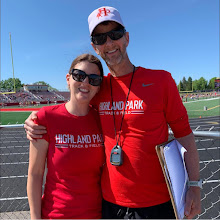The chapter that I wanted to re-read is Joe Rubio’s chapter on “Devising an Efficient Training Plan.” I can’t remember when or where I first became aware of Joe Rubio. I imagine it was on a message board, most likely Beck’s Donnybrook or Merv, both which happen to be defunct now. In any case, Rubio was always very unselfish when it came to sharing his knowledge. In addition to posting his thoughts on message boards, he also took time to answer my personal emails, even though he was busy coaching much better runners, including 4 of the top 22 women at the 2004 Olympic Trials Marathon.
As I mentioned, it seems like Rubio’s chapter was written specifically for me. It starts out;
If you consider yourself a competitive distance runner, chances are that much of the enjoyment you derive from running depends on racing your best…If this describes your running purpose, then you have probably played around with your training schedule in an attempt to improve your race performances, and maybe you’ve had mixed results…Unfortunately for many runners, attempts at varying their own training menu rarely produce significantly better race results. Thus, the question arises after several seasons of trial and error: Is there a consistent training program that I can use to achieve success, or is this really as fast as I can run?
I won’t list them here, but Rubio goes on to list 6 key specific elements that must be included in your training routine consistently, as well as how to apply them in order to enjoy success. One thing I wasn’t clear on when I first read the chapter is whether or not Rubio incorporates these 6 elements all year long or only after a base has been built. So I emailed him for some clarification. He said it depends on if you like a traditional build up or if you’d rather not be too far from race-fit during the year. Since I don’t race seriously during the winter here were his base-building suggestions for me;
Higher volume of weekly mileage.
Weekly or consistent tempos, which should be longer and less intense. For example, instead of 4 miles at 6:00, try 6 at 6:15 or 8 at 6:30.
If available, add a hilly run per week; 12-15% of weekly mileage.
Strides
Ancillary stuff like strengthening core, hamstrings, upper body, flexibility, diet, etc.
Once you do this for 2-3 months, start the multi-paced training that’s mentioned in the book.
Here are a couple other passages from Joe’s chapter that I like;
Many distance runners try to make training infinitely more complex than it needs to be. However, successful training is surprisingly similar across the spectrum of distances from 1,500 meters to the marathon.
I cannot name one individual heroic workout that will take someone to the next level, but there are a few workouts that, when done consistently and repetitively as part of a training schedule, can lead to substantial progress for the majority of runners.
As for my own training, the cutback week continued with an easy 7 mile run this morning. After 0, 5, and 7 miles the last 3 days, I'm feeling refreshed and ready to go.
Finally, if you like the elite runner’s journals I’ve been linking, check out Carrie Tollefson’s and Kristin Nicolini’s recent updates.
Quote of the day;
“Physical training takes place at the level of the cell. That’s why nothing in training is more important than patience.” – John Jerome, The Elements of Effort

No comments:
Post a Comment